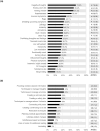Patient-identified priorities for a mental health program tailored to premenstrual dysphoric disorder
- PMID: 40512977
- PMCID: PMC12166257
- DOI: 10.1177/17455057251331697
Patient-identified priorities for a mental health program tailored to premenstrual dysphoric disorder
Abstract
Background: There are no mental health programs tailored to premenstrual dysphoric disorder (PMDD).
Objectives: Examine the content and features that PMDD patients desire in a mental health program.
Design: Anonymous online survey.
Methods: A survey, co-developed with PMDD patients, was distributed to followers of the International Association for Premenstrual Disorders (IAPMD) on social media. Respondents rated the importance of addressing various PMDD symptoms, psychosocial consequences, psychoeducational topics, and their preference for various techniques and features.
Results: In total, 308 respondents rated suicidality, feelings of hopelessness and anxiety, and impacts on one's relationship with one's partner and children as important content areas for a PMDD-tailored mental health program. Providing evidence-based information and teaching techniques for managing distressing thoughts and emotions were also highly desired.
Conclusion: Our findings help inform the development of a new mental health program that specifically addresses the unique emotional and psychosocial challenges associated with PMDD.
Keywords: patient-centered; premenstrual disorders; premenstrual dysphoric disorder; psychotherapy; self-help intervention.
Plain language summary
What do PMDD patients need in a mental health program?Premenstrual dysphoric disorder (PMDD) affects 1-3% of menstruating individuals and is characterized by cyclical psychiatric symptoms for 1-2 weeks before the start of a period. There are no mental health programs tailored to PMDD. Through an anonymous online survey, co-developed with patients, we examined the content and features that PMDD patients desire in a mental health program. Analysis of 308 survey respondents show that suicidality, feelings of hopelessness and anxiety, and impact on one’s relationship with one’s partner and children were rated as important content areas for a PMDD-tailored mental health program. Survey results also show that evidence-based information and techniques for managing distressing thoughts and emotions were highly desired. These findings highlight patient-informed needs that can help in the development of a new mental health program, specifically addressing the unique challenges associated with PMDD.
Conflict of interest statement
The authors declared the following potential conflicts of interest with respect to the research, authorship, and/or publication of this article: Dr. Jennifer L. Gordon is the Clinical Advisory Board Chair for the International Association of Premenstrual Disorders (IAPMD). Dr. Sneha Chenji is an independent contractor (Research and Education) for IAPMD.
Figures
Similar articles
-
Developing a Mood and Menstrual Tracking App for People With Premenstrual Dysphoric Disorder: User-Centered Design Study.JMIR Form Res. 2024 Dec 24;8:e59333. doi: 10.2196/59333. JMIR Form Res. 2024. PMID: 39718601 Free PMC article.
-
Non-contraceptive oestrogen-containing preparations for controlling symptoms of premenstrual syndrome.Cochrane Database Syst Rev. 2017 Mar 3;3(3):CD010503. doi: 10.1002/14651858.CD010503.pub2. Cochrane Database Syst Rev. 2017. PMID: 28257559 Free PMC article.
-
Selective serotonin reuptake inhibitors for premenstrual syndrome and premenstrual dysphoric disorder.Cochrane Database Syst Rev. 2024 Aug 14;8(8):CD001396. doi: 10.1002/14651858.CD001396.pub4. Cochrane Database Syst Rev. 2024. PMID: 39140320 Free PMC article.
-
Gonadotropin-releasing hormone (GnRH) analogues for premenstrual syndrome (PMS).Cochrane Database Syst Rev. 2025 Jun 10;6(6):CD011330. doi: 10.1002/14651858.CD011330.pub2. Cochrane Database Syst Rev. 2025. PMID: 40492482 Review.
-
Emotion regulation-based internet-delivered cognitive behavioural therapy for premenstrual dysphoric disorder: study protocol for a randomised controlled trial in Sweden.BMJ Open. 2025 Jan 22;15(1):e091649. doi: 10.1136/bmjopen-2024-091649. BMJ Open. 2025. PMID: 39843366 Free PMC article.
References
-
- Reilly TJ, Patel S, Unachukwu IC, et al. The prevalence of premenstrual dysphoric disorder: Systematic review and meta-analysis. J Affect Disord 2024; 349: 534–540. - PubMed
-
- Gynecologists ACoOa. Management of premenstrual disorders: acog clinical practice guideline no. 7. Obstet Gynecol 2023; 142(6): 1516–1533. - PubMed
-
- Hunter MS, Ussher JM, Cariss M, et al. Medical (fluoxetine) and psychological (cognitive-behavioural therapy) treatment for premenstrual dysphoric disorder: a study of treatment processes. J Psychosom Res. 2002; 53(3): 811–817. - PubMed
-
- Weise C, Kaiser G, Janda C, et al. Internet-based cognitive-behavioural intervention for women with premenstrual dysphoric disorder: A randomized controlled trial. Psychother Psychosom. 2019; 88(1): 16–29. - PubMed
Publication types
MeSH terms
LinkOut - more resources
Full Text Sources
Medical


